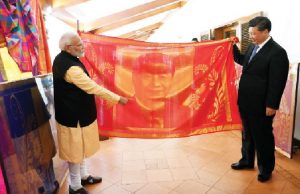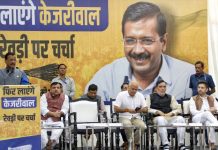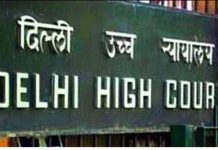 Recent two-day visit to India by Chinese President Xi Jinping and his informal meeting with Prime Minister Narendra Modi at the world heritage site of Mahabalipuram, in Tamil Nadu is construed as a welcome development in the aftermath of China’s stance on recent development in the Indian state of Jammu and Kashmir. Exchange of high-level visits and one-to-one talks between the top leaders of India and China affords opportune occasion to iron out mutual differences and provides impetus to bilateral relations devoid of delusions.
Recent two-day visit to India by Chinese President Xi Jinping and his informal meeting with Prime Minister Narendra Modi at the world heritage site of Mahabalipuram, in Tamil Nadu is construed as a welcome development in the aftermath of China’s stance on recent development in the Indian state of Jammu and Kashmir. Exchange of high-level visits and one-to-one talks between the top leaders of India and China affords opportune occasion to iron out mutual differences and provides impetus to bilateral relations devoid of delusions.
President Xi was accorded a grand warm welcome on his arrival at Mahabalipuram. Responding to the welcome, President Xi said, “We are really overwhelmed by your hospitality. My colleagues and I have felt that very strongly. This will be a memorable experience for me and for us.” During the first day of his visit on Friday on October 11, the visiting Chinese President held “heart-to-heart” and “candid discussions like friends” with Prime Minister Modi. This was their second informal meeting- the first being in China’s Wuhan in April 2018. The discussions between the two leaders on their first-day summit that lasted for five hours, veered round trade and economy among other issues. The second day summit that lasted for one hour witnessed one-to-one talks.
Calling upon both sides ought to be taking a correct view of each other’s developments and enhance strategic mutual trust, President Xi said, “No matter from any point of view, China and India should be good neighbours and good partners who live in harmony and move forward hand in hand.” A statement issued after President XI’s two-day visit quoted Xi as saying, “To achieve Dragon and Elephant Dance is the only correct choice for China and India, which is in the fundamental interests of both countries and their peoples.”
The talks between the two leaders were followed by delegation-level talks in the end and President Xi called for viewing the differences between the two countries in a correct way. Cautioning that differences should not be allowed to dilute the overall interests of bilateral cooperation, President Xi said: “… We should seek understanding through communication and constantly resolve differences. The two countries should and should be able to walk out of a grand road of friendly cooperation between two neighbouring powers… China hopes to develop itself well and India well. China and India should make mutual achievements and illuminate each other.”
In a statement after leaving India on October 12, President Xi suggested that both countries should carry out strategic communication in a timely and effective manner. Suggesting that the next few years would be critical for the two countries, Chinese President added: “We should carefully handle issues concerning each other’s core interests. We should properly manage and control problems that cannot be solved for the time being,” also further noting that India and China should develop “military-to-military relations in the right direction of enhancing trust, clearing up misgivings and friendly cooperation”.
Catch-22 situation
India is in a catch-22 situation vis-à-vis China. Having expressed resentment over China’s stance over Modi government’s move of diluting the Article 370 with regard to J&K, the sudden bonhomie between Beijing and New Delhi in the wake of President Xi’s recent two-day visit to India has perplexed some observers whereas some observers view it as a positive development in bilateral ties. Nevertheless, this author is of the view that protracted ongoing trade spar between Washington and Beijing on one hand and growing proximity between the US and India coupled with the fact of internal turmoil in Hong Kong and Uighur question are major compulsive factors that compel China to maintain cordial relations with India and not to incur India’s ire by extending support to Pakistan at India’s expense. In other words, the probability of China perceiving its relations with India independent of Pakistan factor gaining salience in Chinese diplomacy cannot be ruled out.
What actually transpired between one-to-one talks spanning over six hours between President Xi and PM Modi is not known. Apparently, both leaders discussed a wide range of topics; nonetheless, the devil was in detain of what Beijing and New Delhi chose to highlight in the respective briefings to the media at the end of the summit. Briefing the media, Indian foreign secretary told that both countries were faced with a “common challenge “from radicalisation which they must fight together. The Indian briefing also noted that both sides also spoke about the trade deficit between the two countries. However, according to Chinese news agency Xinhua, the two leaders “held an extensive talk during the tour on dialogue and mutual learning among civilizations” in which Xi told Modi that Tamil Nadu, as “maritime transit hub for cargoes in the ancient silk road”, has a long history of exchanges with China.
The Indian media briefing informed that there was a general discussion on trade issues and on trying to identify new areas for investment and how to enhance the trade volume and trade value. The discussion also included the matter of “trade deficit and trade imbalance. As per Chinese official data, in 2018, India and China bilateral trade stood at $95 billion, with the trade deficit recorded at $57.86 billion. China had invested an estimated $ 2 billion in 2017 in India ass compared to $ 700 million in 2016. Some critics have opined that reference to “radicalisation” should not be construed in terms of China acceding to India’s expectations that Beijing would push Pakistan to take action against terror groups based in Pakistan. China’s perceptions of radicalism emanating from Uighur Muslim community in Xinjiang province are different from India’s perceptions and these critics rule out the likelihood of Beijing pressurizing Islamabad in this regard to please India. A close reading in between the lines of the two media briefings makes it discernible that nevertheless, there has been no immediate substantial strategic gain for India from President Xi’s visit; nonetheless, both sides are politically and economically engaged in negotiations to carry forward their relations.
Pakistan factor
Undoubtedly, Pakistan shares an all-weather friendship with China and prime minister of Pakistan has recently described his country’s ties with china “an anchor for regional stability” and besides this, China adhered to a series of measures favouring Pakistan in the aftermath of India’s actions in J&K, again proving that China is Pakistan’s irreplaceable ally; nevertheless, recent visit of President Xi to India exhibits a change albeit temporary in Beijing’s attitude to Sino-India relations to be decoupled from Pakistan. President Xi’s visit to India cannot and should not be construed as Beijing’s tilt towards India; nevertheless, it should be viewed as part of China’s compulsive diplomacy of not souring its relations with New Delhi and keep the latter in good humour diplomatically owing primarily to geopolitical and geo-economic compulsions dictated by disenchantment between Beijing and Washington in the wake of ongoing trade spar and china’s tactical gambit of pursuing time-buying diplomacy to maintain regional ambience suitable for pursuing its long-term programme of attaining military and technological supremacy vis-à-vis the United States.
Beijing can ill-afford to let Islamabad slip out of its grip, especially at a time when it has made huge economic and strategic investments in Pakistan. Besides, Pakistan is a strategic asset for Beijing to keep India militarily and economically bogged down.
Way Forward
According to one opinion, India’s relationship with China has often swung back and forth between paranoia and deep suspicion to a calmer assessment of the situation. The notion of unstructured, free-wheeling discussions originated at Kazakh capital Astana in June 2017 where PM Modi and President Xi met together in the backdrop of Shanghai Cooperation Organisation (SCO) Summit. Breaking away from the protocol bound bilateral meetings, the new format affords free-wheeling, frank conversations between leaders.
However, some experts have opined that Modi-Xi meeting at Mahabalipuram in Tamil Nadu had little to do with providing a major thrust to India-China relations; and more to do with improving BJP’s electoral prospects in Tamil Nadu because Modi’s charm offensive has not conquered Tamil Nadu. By dressing himself in the veshti-and-angavastram, Modi perhaps quite clearly signaled an indication of a kind of “Tamil Connect” than what was officially spoken of. As one critic has surmised, for the BJP in general and PM Modi especially, domestic politics is never forgotten, even if it comes via international diplomatic channels.












